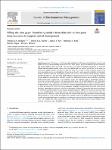Filling the data gaps: Transferring models from data-rich to data-poor deep-sea areas to support spatial management
| dc.contributor.author | Bridges, AEH | |
| dc.contributor.author | Barnes, DKA | |
| dc.contributor.author | Bell, JB | |
| dc.contributor.author | Ross, RE | |
| dc.contributor.author | Voges, L | |
| dc.contributor.author | Howell, KL | |
| dc.date.accessioned | 2023-07-18T15:24:27Z | |
| dc.date.available | 2023-07-18T15:24:27Z | |
| dc.date.issued | 2023-11 | |
| dc.identifier.issn | 0301-4797 | |
| dc.identifier.issn | 1095-8630 | |
| dc.identifier.other | 118325 | |
| dc.identifier.uri | https://pearl.plymouth.ac.uk/handle/10026.1/21052 | |
| dc.description.abstract |
Spatial management of the deep sea is challenging due to limited available data on the distribution of species and habitats to support decision making. In the well-studied North Atlantic, predictive models of species distribution and habitat suitability have been used to fill data gaps and support sustainable management. In the South Atlantic and other poorly studied regions, this is not possible due to a massive lack of data. In this study, we investigated whether models constructed in data-rich areas can be used to inform data-poor regions (with otherwise similar environmental conditions). We used a novel model transfer approach to identify to what extent a habitat suitability model for Desmophyllum pertusum reef, built in a data-rich basin (North Atlantic), could be transferred usefully to a data-poor basin (South Atlantic). The transferred model was built using the Maximum Entropy algorithm and constructed with 227 presence and 3064 pseudo-absence points, and 200 m resolution environmental grids. Performance in the transferred region was validated using an independent dataset of D. pertusum presences and absences, with assessments made using both threshold-dependent and -independent metrics. We found that a model for D. pertusum reef fitted to North Atlantic data transferred reasonably well to the South Atlantic basin, with an area under the curve of 0.70. Suitable habitat for D. pertusum reef was predicted on 20 of the assessed 27 features including seamounts. Nationally managed Marine Protected Areas provide significant protection for D. pertusum reef habitat in the region, affording full protection from bottom trawling to 14 of the 20 suitable features. In areas beyond national jurisdiction (ABNJ), we found four seamounts that provided suitable habitat for D. pertusum reef to be at least partially protected from bottom trawling, whilst two did not fall within fisheries closures. There are factors to consider when developing models for transfer including data resolution and predictor type. Nevertheless, the promising results of this application demonstrate that model transfer approaches stand to provide significant contributions to spatial planning processes through provision of new, best available data. This is particularly true for ABNJ and areas that have previously undergone little scientific exploration such as the global south. | |
| dc.format.extent | 118325-118325 | |
| dc.format.medium | Print-Electronic | |
| dc.language | en | |
| dc.publisher | Elsevier BV | |
| dc.subject | Habitat suitability modelling | |
| dc.subject | Novel approaches | |
| dc.subject | Cold-water coral reef | |
| dc.subject | Marine spatial planning | |
| dc.subject | Model transfer | |
| dc.subject | Area beyond national jurisdiction | |
| dc.title | Filling the data gaps: Transferring models from data-rich to data-poor deep-sea areas to support spatial management | |
| dc.type | journal-article | |
| dc.type | Article | |
| plymouth.author-url | https://www.ncbi.nlm.nih.gov/pubmed/37390730 | |
| plymouth.volume | 345 | |
| plymouth.publisher-url | http://dx.doi.org/10.1016/j.jenvman.2023.118325 | |
| plymouth.publication-status | Published | |
| plymouth.journal | Journal of Environmental Management | |
| dc.identifier.doi | 10.1016/j.jenvman.2023.118325 | |
| plymouth.organisational-group | |Plymouth | |
| plymouth.organisational-group | |Plymouth|Research Groups | |
| plymouth.organisational-group | |Plymouth|Faculty of Science and Engineering | |
| plymouth.organisational-group | |Plymouth|Faculty of Science and Engineering|School of Biological and Marine Sciences | |
| plymouth.organisational-group | |Plymouth|Research Groups|Marine Institute | |
| plymouth.organisational-group | |Plymouth|REF 2021 Researchers by UoA | |
| plymouth.organisational-group | |Plymouth|Users by role | |
| plymouth.organisational-group | |Plymouth|Users by role|Academics | |
| plymouth.organisational-group | |Plymouth|REF 2021 Researchers by UoA|UoA07 Earth Systems and Environmental Sciences | |
| plymouth.organisational-group | |Plymouth|Users by role|Researchers in ResearchFish submission | |
| dc.publisher.place | England | |
| dcterms.dateAccepted | 2023-06-03 | |
| dc.date.updated | 2023-07-18T15:24:26Z | |
| dc.rights.embargodate | 2023-7-20 | |
| dc.identifier.eissn | 1095-8630 | |
| dc.rights.embargoperiod | forever | |
| rioxxterms.versionofrecord | 10.1016/j.jenvman.2023.118325 |


